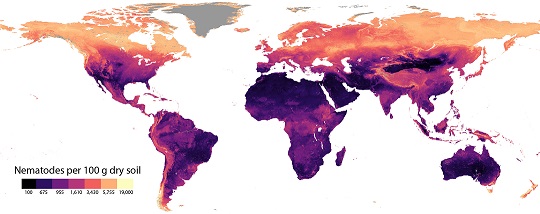Using AI to control energy for indoor agriculture
30 September 2024
Published online 1 August 2019
Study measures nematode biomass from cold regions to hot deserts.

© Johan van den Hoogen
An international team of researchers, including a scientist in Morocco, analyzed soil samples from 73 locations to map nematode densities worldwide.
They found that almost 40 percent of the world’s nematodes thrive in the frigid soils of boreal forests and the tundra. A quarter reside in temperate regions and another 20 percent live in tropical and sub-tropical regions. The total global biomass of these worms is three times greater than a previous estimate and represents 82% of total human biomass on Earth.
The team suggests that worm densities fluctuate due to varying concentrations of soil organic carbon. Higher levels in the Rocky Mountains, the Himalayan Plateau and the Alps boost nematode numbers. Low soil organic carbon is associated with low nematode densities in the Sahara, Arabian, Gobi, and Kalahari deserts.
Other factors that can also play a role are soil texture, acidity, temperature and rainfall.
The researchers found that nematodes are a major player in global soil carbon cycling, exhaling about 2.2 percent of soil carbon emissions — an amount roughly equivalent to 15 percent of fossil fuel carbon emissions.
The findings are expected to help identify regions most in need of protection and that could benefit from restoration efforts, says ecologist and lead researcher Johan van den Hoogen of ETH Zürich, Switzerland.
Earth surface scientist, Franciska de Vries of the University of Amsterdam, who was not involved in the study, says the research significantly advances our understanding of the global distribution of nematodes and their contributions to carbon and nutrient cycling in soil.
doi:10.1038/nmiddleeast.2019.111
Hoogen, J. et al. Soil nematode abundance and functional group composition at a global scale. Nature https://doi.org/10.1038/s41586-019-1418-6 (2019).
Stay connected: